Hammer adventures from Indicator
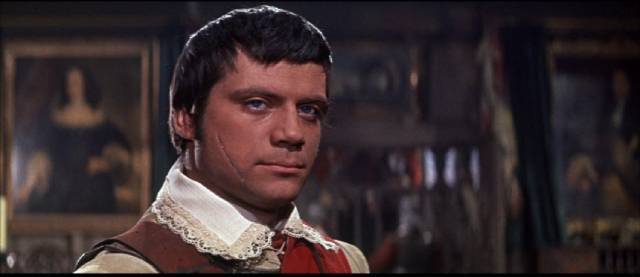
When Indicator announced Death & Deceit, the fifth box set in their series of Hammer Films releases, back at the beginning of the year, I was disappointed. Although previous volumes had included some weaker films, this whole set didn’t seem that interesting to me – one attempt at a contemporary thriller and three historical adventures, not a horror or psychological thriller in sight. While it’s admirable that Indicator is covering the whole range of Hammer’s output, I couldn’t work up much enthusiasm, particularly in light of the really strong volume 4. But, given my completist compulsion, I ordered the set anyway.
I wasn’t reassured when I watched the first movie in the set – Michael Carreras’ Visa to Canton – but was soon won over by the three subsequent features, which comprise a tribute to writer-director John Gilling, who has long remained in the shadow of Hammer’s signature director, Terence Fisher. Gilling initially made his mark with a number of B-movie thrillers and adventure films in the 1950s, culminating in The Flesh and the Fiends (1960), produced by Monty Berman and Robert S. Baker, the team who successfully imitated Hammer on lower budgets in the wake of the studio’s initial Gothic horrors. That excellent retelling of the Burke and Hare story led to Gilling being hired by Hammer, where the next year he made an atmospheric but rather absurd little horror called The Shadow of the Cat (1961).
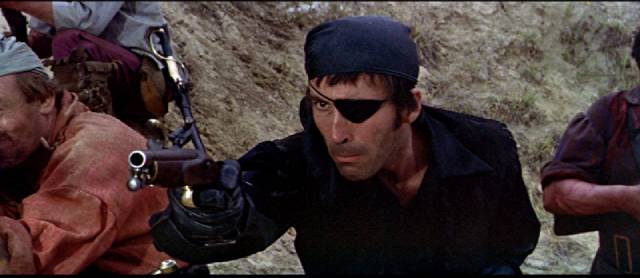
Although somewhat bound by the template established by Fisher, Gilling, who wrote or co-wrote many of his films, pushed against those constraints. Where Fisher is recognized for the romanticism running through his horrors – his belief in redemption and good triumphing over evil – Gilling had a darker outlook. His films have a strong streak of ambiguity and often end without offering the audience reassurance. This is certainly true of the two Gothic horrors he made for the studio, which also happen to be two of their best – The Plague of the Zombies and The Reptile (both 1966). And it’s also true of the historical adventures he made for Hammer, superficially rousing stories for adolescent boys, yet shot through with betrayals, uncertainty and shifting identities, which constantly undermine audience identification.
But first, that mediocre thriller…
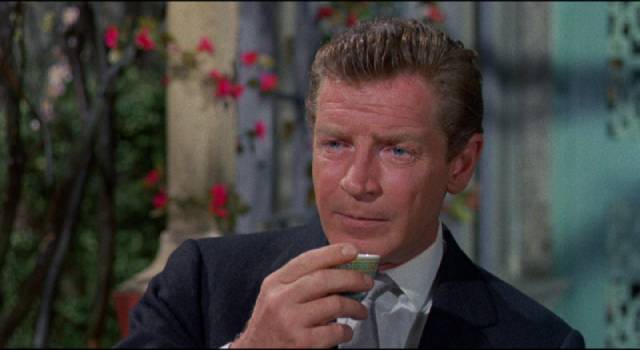
Visa to Canton (Michael Carreras, 1960)
Michael Carreras was one of Hammer’s most important producers (IMDb lists 69 producer credits, most for the studio), but he also occasionally directed (ten features between 1957 and 1974), with most of his work plodding and uninspired. I’ve seen half of them over the years, but had never even heard of this, his second feature, until it was mentioned in connection with Anthony Bushell’s Terror of the Tongs in set 2; the two films were shot back to back, using the same sets, although one was contemporary and the other a period movie.
Visa to Canton feels rather small and poky, although it uses a fair amount of stock footage of Hong Kong to give it a bit of scale. With a script by Anglo-Chinese writer Gordon Wellesley, and an American star, it strives for international thrills, but feels like a television show (some sources even suggest that it was in fact a TV pilot, though the use of wide screen and colour make that unlikely). As with Terror of the Tongs (which also has that cramped feeling), one of its main problems is the issue of casting many western actors as Chinese characters, though Wellesley’s script treats the Chinese with a bit more sympathy and even respect.
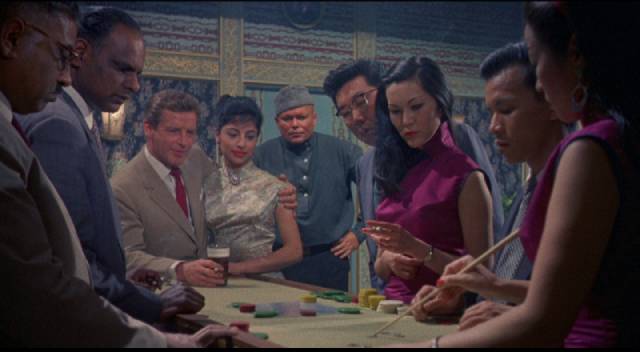
The plot revolves around a plane heading from Taiwan to Hong Kong which is somehow diverted off course and crashes on the mainland. On board is an American agent carrying crucial information. Because of the situation’s sensitivity, an American official approaches Don Benton (Richard Basehart) for help. Benton is a former soldier who fought with the Chinese during the War and settled in Hong Kong afterwards, all but being adopted by the Mao family. Jimmy Mao (Burt Kwouk) was the plane’s pilot, so Benton reluctantly agrees to sneak into China hoping to find him and bring him back. This sequence involves taking a boat upriver, where it encounters a couple of Red Chinese soldiers as Jimmy swims out from shore to be rescued – that’s pretty much it for action until the climax, and it takes place on the very familiar stretch of the River Thames which Hammer frequently used.
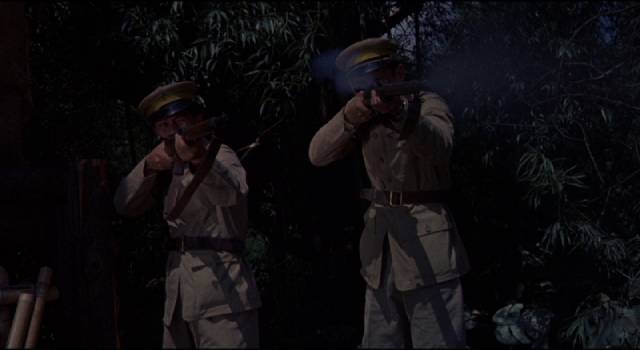
Back in Hong Kong, Jimmy is arrested by the British authorities who suspect that he deliberately dumped the plane to allow the Chinese to get their hands on the agent. Benton again bows to pressure and heads for Canton to try and locate and rescue the agent. His cover is his actual identity – he runs a big travel agency which facilitates western tourists getting access to Asian countries – and he uses an apparent business trip, hoping to open up China, as an excuse to infiltrate the closed country.
The Chinese know what he’s up to, though; he’s known to the local head of intelligence, Ivono Kong (Eric Pohlmann), from the war, and they play a bit of cat-and-mouse with each other as the agent is identified as Lola Sanchez (Lisa Gastoni). Loyalties are blurred, people are betrayed, and in the rush to escape Canton, some die. This climactic sequence is interesting because it takes place during the Great Sparrow Campaign, something I’d never heard of – the population were prompted by Mao to get out and make a racket for hours so that sparrows would be forced to keep flying until they dropped from exhaustion. The idea was that the birds were a pest eating too much of the crops. As so often happens when we interfere with the way nature works, with the birds gone there was an insect (the birds’ primary diet) population explosion resulting in a devastating famine as the crops were stripped bare.
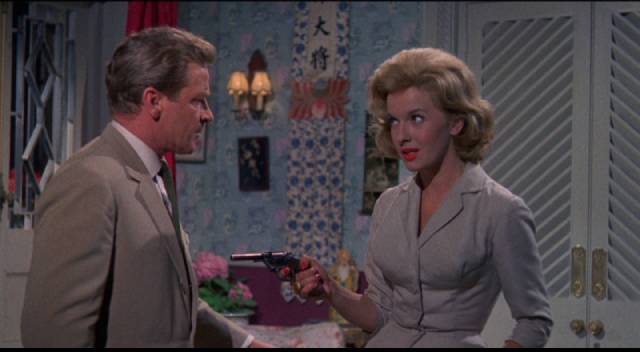
That information isn’t in the movie, though, so we just get an odd carnival scene, with noisy people in masks (not an authentic detail, but used to hide the lack of Asian extras) providing cover for the chase and escape.
Visa to Canton operates on the level of something like The Saint rather than a globe-trotting spy thriller … but there is one fascinating detail: Edwin Astley’s score is built around a theme which is suspiciously Bond-like two years before Monty Norman’s signature tune defined escapist espionage for the next six decades.
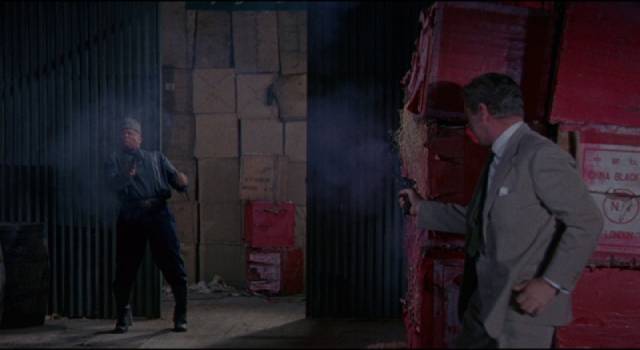
Richard Basehart gives the kind of no-nonsense performance common to American actors slumming in British films of the period, though he is a reluctant hero and is often dominated by other, more forceful characters. Lisa Gastoni is a proto-Bond heroine whose loyalties are uncertain, while the presence of the familiar Burt Kwouk serves to make the Europeans in racial drag all the more obvious – particularly Eric Pohlmann as the villain and grand dame Athene Seyler, a fixture on English stage and screen for half a century, as Kwouk’s grandmother.
Carreras’ movie was an attempt by Hammer to branch out – with an ending which promises more adventures for travel agent Don Benton – but it didn’t lead to a new direction for the studio, though Carreras returned to this territory again for his final film, Shatter (1974), another contemporary thriller set in Hong Kong.
*
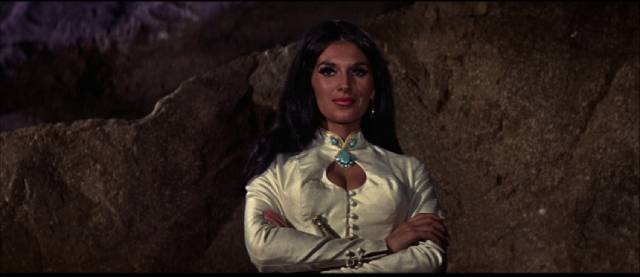
John Gilling
Unlike Carreras, John Gilling knew how to craft compelling films, tightly structured, well-acted, which are almost always models of narrative clarity even as many of the characters display ambiguous motives and uncertain loyalties. Word has it that Gilling was pretty unpleasant to work for, with a hair-trigger temper and a nasty streak which made him abusive towards cast and crew. It’s a tribute to his collaborators in front of and behind the camera that this didn’t prevent most of them doing fine work in his films. Personality aside, Gilling’s work has always suited me better than Fisher’s, though I now appreciate Fisher more than I did back when I first saw his movies. Fisher seems much more staid compared to Gilling’s vigour, and that sense of ambiguity in Gilling makes his movies linger longer in my memory.
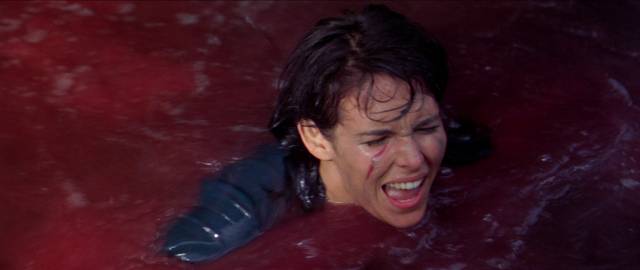
The Pirates of Blood River (1962)
As a child in England, I missed all the Hammer horrors when they were first released – they were rated X, unlike in the United States where they were considered kiddie matinee entertainment – so my first encounter with the studio was John Gilling’s The Pirates of Blood River (1962), which I saw in a theatre when I was seven. All that I remembered for years were characters being eaten by piranha, being dragged down into the churning water of the titular river. I’ve seen it a number of times in recent years – first on DVD, then on Twilight Time’s Blu-ray, and now as part of this Indicator set – and there’s much more to it than those brief moments of horror.
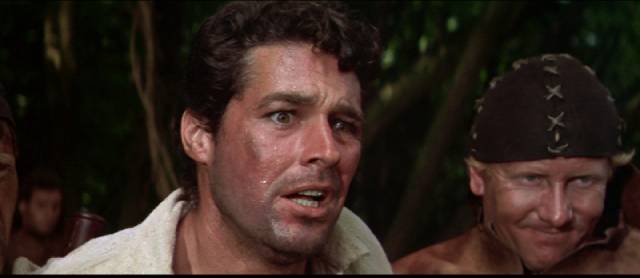
The project began with Jimmy Sangster being challenged to write a pirate movie which didn’t take place at sea because the studio couldn’t afford a ship. After some stock footage of a square rigger under the opening titles, it all takes place on land – specifically an island in the Caribbean. A colony of Huguenots which had fled persecution in France a hundred years earlier has devolved into a rigid and oppressive society ruled by a small council of elders; a younger generation chafes at the rules, not least Jonathan Standing (Kerwin Matthews), the son of the head elder, Jason Standing (Andrew Keir). Having been caught dallying with the younger wife (Marie Devereux) of one of the elders, Jonathan is put on trial and sentenced by his father to fifteen years of hard labour in the colony’s brutal prison. (The young woman fares worse – running from the men who catch the couple in flagrante, she plunges into the river and gets eaten by those piranha.)
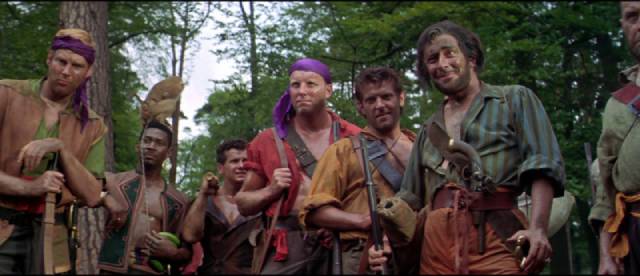
Managing to escape from the prison, Jonathan flees through a swamp and is found exhausted by a band of pirates led by Captain LaRoche (Christopher Lee), who has heard rumours that there is some hidden treasure in the colony. Jonathan assures them that there isn’t any wealth, but takes them at their word that they’ll help him topple the ruling council. Needless to say, the pirates aren’t reliable and once he leads them back home, they start abusing the population – attempting to rape a couple of women, killing a farmer. When they attack the fortified village, Jonathan is caught in a sticky place; the colonists can see that he led the pirates to their gates, but he now has to find a way to protect them despite their distrust.
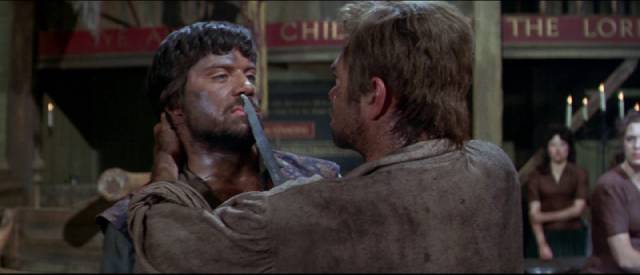
Overwhelmed by the superior force, the villagers are all taken prisoner and the pirates set about looking for the treasure. Even when LaRoche threatens to start killing people, Jason Standing continues to deny the existence of treasure. It’s up to John, his friend Henry (Glenn Corbett) and his sister Bess (Marla Landi) to come up with a plan to defeat the pirates. After some killings and an escape, LaRoche discovers that the towering statue of the colony’s founder is made of solid gold – all the wealth the refugees brought with them when they fled France, tied up and concealed, serving no actual purpose. When they load it on a wagon to drag back to their ship, Jason insists on going with it because for him it seems to be the only thing that has meaning and purpose; meanwhile the young rebels pick the pirates off one by one until they reach the river. As the rebels and the pirates battle each other, Jason clings to the raft carrying the statue, only to end up as fish food as the pointless wealth sinks into the murky water.
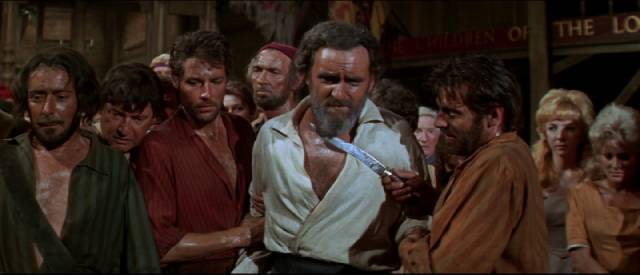
The colony has been undone by religious fanaticism and greed, the pirates destroyed, and the young folk prepare to start over with a more liberated society. Given Gilling’s depiction of human behaviour, it’s questionable whether they’ll do much better than their elders in the long run.
The Pirates of Blood River stars a couple of American actors for supposed box office value, but what makes it so entertaining is the cast of Hammer regulars, with Lee pompously menacing as LaRoche, Keir excellent as a man who has completely lost any sense of purpose because of his fixation on the hidden gold, and Peter Arne, Michael Ripper and Oliver Reed as the most prominent members of the pirate crew.
*
Oliver Reed features prominently in the two subsequent films in the set. After years of bit parts (many uncredited), the actor was given his first real break as Leon in Curse of the Werewolf (1961), followed immediately by Pirates and then a range of roles in period and contemporary films, before moving on to star in a number of films for Michael Winner and others. For Gilling, Reed had significant roles in The Scarlet Blade (1963) and The Brigand of Kandahar (1965).
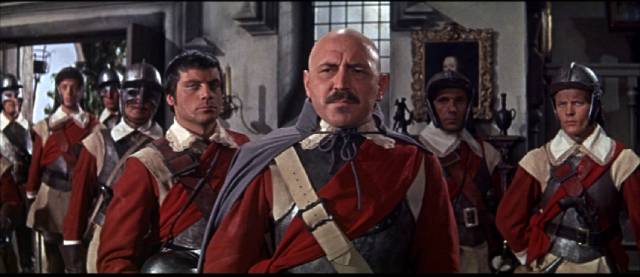
The Scarlet Blade (1963)
The Scarlet Blade is set in 1648 during the English Civil War. I used to know more about the period because it’s prominent in both history and popular culture. What I recall from my childhood is the idea that the Royalists, supporters of Charles I, were the dashing romantic side – for similar reasons, no doubt, as the South in American history: they had a flashier fashion sense and elegant manners – while the Roundheads under Cromwell (named for their close-cropped hair in contrast to the Royalists’ flowing locks) were a grim and humourless bunch. Cromwell did become a dictator, but the King was pretty awful too.
As in many Hollywood movies which idolize the South, Gilling’s film sides with the Royalists as it tells of a group of rebels who are trying to save the King as Crowell’s forces take control of the whole country. The Scarlet Blade is Edward Beverley (Jack Hedley), elder son of a squire murdered by one of Cromwell’s officers. That villain is Colonel Judd, played by Lionel Jeffries, who was more familiar as a comedic actor; here, he’s a chilling fanatic, all the more fierce for having switched sides. Judd moves into the family mansion with his men, knowing that the Beverleys are involved in trying to spirit the King away to France.
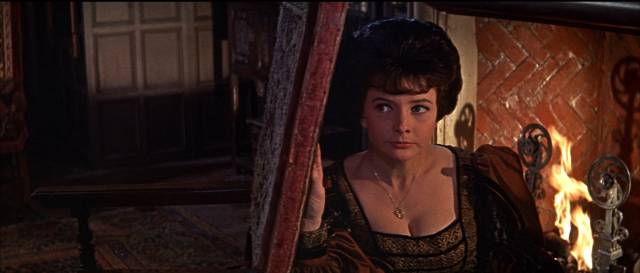
Judd’s daughter Clare (June Thorburn) is appalled by her father’s actions and falls for Edward. But Judd’s second-in-command Captain Tom Sylvester (Oliver Reed) believes he’ll be marrying Clare with her father’s blessing. Realizing that she has joined the Royalists, Sylvester switches loyalties in an attempt to gain her love … or does he? His actual loyalties are clouded. In fact, almost everyone is hard to pin down. Circumstances have forced them all to choose sides and whether this is a matter of genuine commitment or simply convenience is not always clear.
In the end, a lot of people die in the struggle, including Edward’s younger brother Philip (Clifford Elkin). Since the King is captured by Cromwell’s forces early on and implacable history says he’d be executed the year after the film’s action takes place, there’s an air of futility in it all. These people are running about killing one another, convincing themselves that it all has some deep meaning when in the end they’ve just wasted their own and others’ lives.
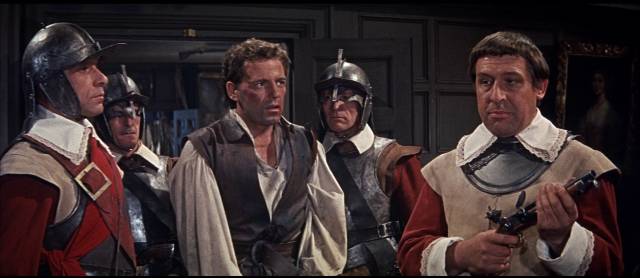
As is often the case, the villains are the most engaging characters, with Jeffries and Reed both giving intense performances which nudge the history towards Hammer’s more familiar Gothic territory, while as the hero Hedley is as bland as oatmeal – hard to believe he’d later turn up in Lucio Fulci’s deeply disturbing The New York Ripper. As always, Hammer stalwarts like Michael Ripper and Duncan Lamont add a great deal of personality and texture to the film.
*
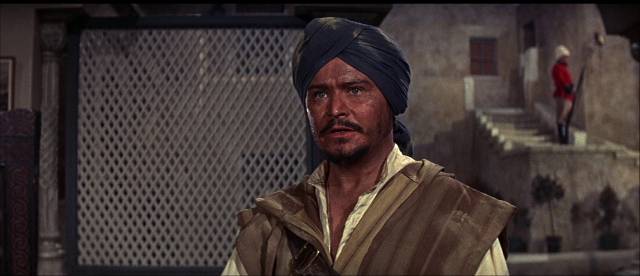
in John Gilling’s The Brigand of Kandahar (1965)
The Brigand of Kandahar (1965)
The Scarlet Blade’s setting ensures that it avoids the pitfalls of racial drag, while The Pirates of Blood River hides the problematic issues of colonialism by having no native population on the island (perhaps the Huguenots slaughtered them all a hundred years earlier?); but the set’s third historical adventure plunges right back into the thick of it, with its setting on the Northwest Frontier at the height of Empire. And yet Gilling once again infuses the adventure with ambiguity, although this movie shows the strain of a limited budget more than the other two; large chunks of The Brigand of Kandahar are filled out with stock footage from other movies, with most of the large-scale movement of armies and the battles coming from Terence Young’s Zarak (1956), on which Gilling was an assistant director.
The theme of divided (or clouded) loyalties is even more pronounced here than in The Scarlet Blade. Lieutenant Case (Ronald Lewis) is disdained by his superiors because of his mixed heritage – half English, half Indian – and the fact that he has been involved in an affair with Elsa Connelly (Katherine Woodville), the wife of a fellow officer, enrages Captain Boyd (Inigo Jackson), who already despises Case for his racial impurity. Things only get worse when Case returns alone from a reconnaissance mission, reporting that Captain Connelly is dead, having been captured by the forces of the rebel leader Eli Khan. This is all everyone needs to shun Case for good; he’s court-martialled for cowardice and sentenced to a lengthy prison term.
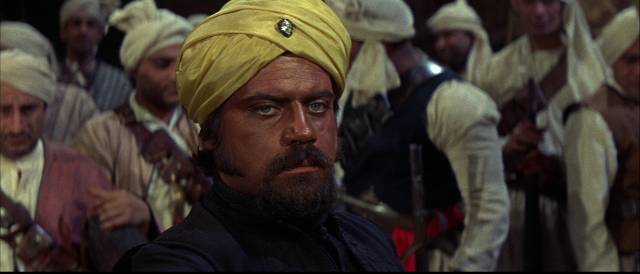
Having worked hard to be British, Case realizes that he can never be accepted and when a native frees him from the stockade, he goes off to join Eli Khan. There on the other side, he’s also a target of distrust, but he’s also very useful, with his knowledge of the British forces and their tactics. Eli Khan sets him to training his men, while Khan’s sister Ratina (Yvonne Romain) becomes attracted to him. When the British come to root out Khan’s forces, Case’s training enables the native forces to rout the enemy and inflict heavy casualties. The Brits are enraged again when they realize a former soldier is helping the rebels and they’re as determined to get Case as they are Khan.
Case’s anger is directed towards the army alone, so he promises clear passage to the civilians who are evacuating Kandahar. But Ratina has no such delicacy and leads a small force out to ambush and slaughter the women, children, old people and their military escort. Naturally, this atrocity is blamed by the British on Case. A pariah in both worlds, all he has left is his torrid romance with Ratina, which ends in an homage to King Vidor’s Duel in the Sun (1946).
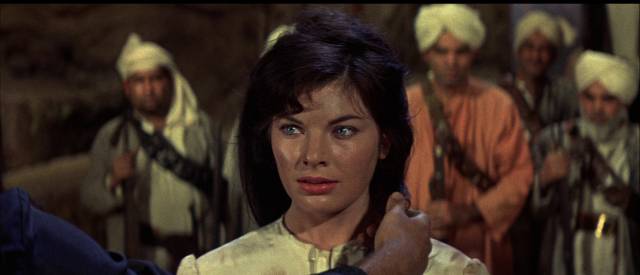
The last word in the film is given to London Times reporter Marriott (Glyn Houston), who has been following the campaign: he pointedly tells Kandahar’s senior officer, Colonel Drewe (Duncan Lamont), that he saw nothing noble in the British victory, but rather witnessed a good man being destroyed by British intolerance and racial prejudice. Things might have turned out very differently if Case had been accepted as the good and dedicated soldier he had originally been…
But even that point remains uncertain, because we discover that Captain Connelly (Jeremy Burnham), although captured by Khan’s men, had not actually been killed. Case’s assertion that he had seen Connelly die was, then, a lie … motivated by his passion for Connelly’s wife perhaps? Maybe he wasn’t such a good soldier after all… In The Scarlet Blade, Gilling doesn’t give us much of a hero; here he gives us no hero at all. Everyone is flawed, though perhaps some have better reasons than others for behaving without nobility.
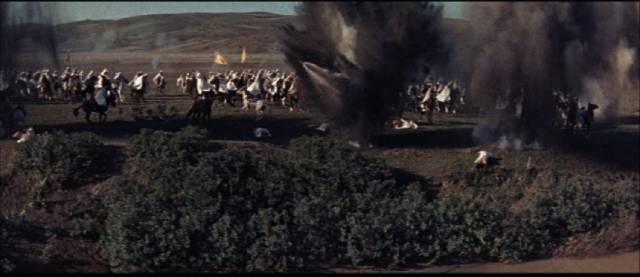
Although Gilling directs with pace and energy, The Brigand of Kandahar has a rickety, patchwork feel – partly because of all that stock footage, into which the characters are occasionally inserted with surprisingly shoddy composite shots, and partly because of the obvious studio exterior sets, small stretches of rocky terrain which wouldn’t be out of place in an episode of the original Star Trek series. We repeatedly get a forced perspective view of the fort which is meant to be in the distance behind the action, but actually looks like a model about fifteen feet behind the actors.
And then there are those actors in blackface. Being only part Indian, Lewis gets away with something like a deep tan, but Oliver Reed as Eli Khan is in full-on racial drag (around the same time that Laurence Olivier was doing the same thing in Othello [1965] and Khartoum [1966], so he was in good company). Yet, despite Reed himself calling Brigand the worst movie he was ever in, he gives an engaging and energetic performance. He might be murderous, but he comes off better than Inigo Jackson as Captain Boyd and Duncan Lamont as Colonel Drewe, both of whom are full-blown villains, putting the British very much on the wrong side of history.
*
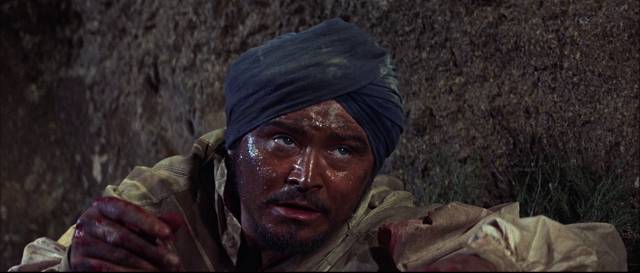
As usual with these Indicator box sets, the quality of the transfers is excellent and there are copious extras. Each movie gets a commentary track; three have introductions by novelist Stephen Laws; each disk has a featurette on the film’s leading actress; music authority David Huckvale discusses all the scores; and there are interviews with critics, historians and some of the people who worked on the movies.
I didn’t have a lot of enthusiasm when I started watching, but in the end thoroughly enjoyed the set.
Comments
Do you know about Monty’s Good Sign Bad Sign? https://www.youtube.com/watch?v=g6EuzGhIyRQ
Interesting … I can definitely hear it buried in there. Astley’s theme is more overtly similar, so maybe there were several levels of cross-fertilization…